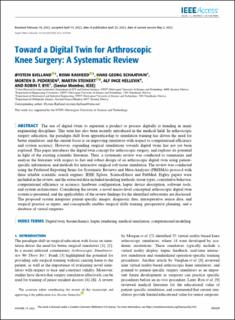| dc.description.abstract | The use of digital twins to represent a product or process digitally is trending in many engineering disciplines. This term has also been recently introduced in the medical field. In arthroscopic surgery education, the paradigm shift from apprenticeship to simulation training has driven the need for better simulators, and the current focus is on improving simulators with respect to computational efficiency and system accuracy. However, expanding surgical simulations towards digital twins has not yet been explored. This paper introduces the digital twin concept for arthroscopic surgery, and explores its potential in light of the existing scientific literature. Thus, a systematic review was conducted to summarize and analyze the literature with respect to fast and robust design of an arthroscopic digital twin using patient-specific information, and methods for interactive surgical soft tissue simulation. The review was conducted using the Preferred Reporting Items for Systematic Reviews and Meta-Analyses (PRISMA) protocol with three reliable scientific search engines: IEEE Xplore, ScienceDirect and PubMed. Eighty papers were included in the review, and the extracted data included modeling methods, tissue types, constitutive behavior, computational efficiency or accuracy, hardware configuration, haptic device description, software tools, and system architectures. Considering the review, a novel macro-level conceptual arthroscopic digital twin system is presented, and the applicability of the review findings for the identified subsystems are discussed. The proposed system integrates patient-specific images, diagnostic data, intraoperative sensor data, and surgical practice as inputs, and conceptually enables surgical skills training, preoperative planning, and a database of virtual surgeries. | en_US |

